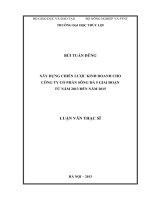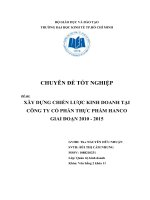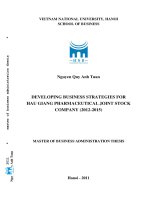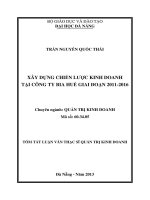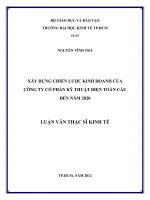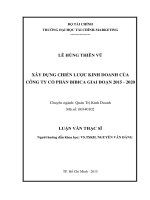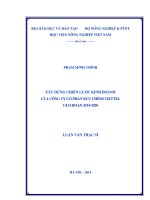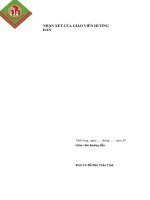(Luận văn thạc sĩ) xây dựng chiến lược kinh doanh cho công ty cổ phần sông đà 11 giai đoạn 2018 2023 và định hướng đến năm 2030
Bạn đang xem bản rút gọn của tài liệu. Xem và tải ngay bản đầy đủ của tài liệu tại đây (1.33 MB, 96 trang )
ĐẠI HỌC QUỐC GIA HÀ NỘI
KHOA QUẢN TRỊ VÀ KINH DOANH
---------------------
TRẦN THANH GIANG
FORMULATION OF BUSINESS STRATEGY
FOR SONG DA 11 JOINT STOCK COMPANY
FOR THE PERIOD 2018 - 2023 AND ORIENTATION TO 2030
XÂY DỰNG CHIẾN LƯỢC KINH DOANH
CHO CÔNG TY CỔ PHẦN SÔNG ĐÀ 11 GIAI ĐOẠN 2018 – 2023
VÀ ĐỊNH HƯỚNG ĐẾN NĂM 2030
LUẬN VĂN THẠC SĨ QUẢN TRỊ KINH DOANH
HÀ NỘI - 2019
ĐẠI HỌC QUỐC GIA HÀ NỘI
KHOA QUẢN TRỊ VÀ KINH DOANH
---------------------
TRẦN THANH GIANG
FORMULATION OF BUSINESS STRATEGY
FOR SONG DA 11 JOINT STOCK COMPANY
FOR THE PERIOD 2018 - 2023 AND ORIENTATION TO 2030
XÂY DỰNG CHIẾN LƯỢC KINH DOANH
CHO CÔNG TY CỔ PHẦN SÔNG ĐÀ 11 GIAI ĐOẠN 2018 – 2023
VÀ ĐỊNH HƯỚNG ĐẾN NĂM 2030
Chuyên ngành: Quản trị kinh doanh
Mã số: 60 34 01 02
LUẬN VĂN THẠC SĨ QUẢN TRỊ KINH DOANH
NGƯỜI HƯỚNG DẪN KHOA HỌC: PGS.TS. HỒNG ĐÌNH PHI
HÀ NỘI - 2019
DECLARATION
The author confirms that the research outcome in the thesis is the result of
author’s independent work during study and research period and it is not yet
published in other’s research and article.
The other’s research result and documentation (extraction, table, figure,
formula,
and other document) used in the thesis are cited properly and the
permission (if required) is given.
The author is responsible in front of the Thesis Assessment Committee,
Hanoi School of Business and Management, and the laws for above-mentioned
declaration.
Date…………………………..
i
ACKNOWLEDGEMENTS
I would like to express my deepest gratitude to all of the following people for
helping me complete my thesis.
Firstly, I would like to express my special thanks to my company for giving
favorable conditions for my study and my master thesis completion at Hanoi school
of business and management (HSB).
Secondly, I am extremely grateful to all of the lecturers from the Department
of Business Administration - HSB for providing me with research methods and
professional knowledge during the course, especially the active and creative
research skills.
My appreciation also goes to the teachers in the thesis review committee for
giving me valuable ideas during my thesis completion process.
My profound gratitude is also conveyed to my instructor for his helpful assistance
and guidance. This thesis could have never been completed without his enthusiastic
counsel and support.
Despite the efforts during the research period, there are still many limitations
in the thesis. I would hope to receive valuable comments from the teachers and coworkers to make this essay more complete.
Thank you very much./.
Ha Noi,
ii
2019
TABLE OF CONTENTS
DECLARATION ............................................................................................... i
ACKNOWLEDGEMENTS .............................................................................. ii
LIST OF TABLES ............................................................................................ v
LIST OF PICTURES ....................................................................................... vi
INTRODUCTION ............................................................................................. 1
Chapter 1: LITERATURE REVIEW ABOUT DESIGNING BUSINESS
STRATEGY ...................................................................................................... 5
1.1. Concept and classification of business strategy ......................................... 5
1.1.1. Concept of business strategy .............................................................. 5
1.1.2. Roles of business strategy ................................................................... 6
1.1.3. Basic characteristics of business strategy ........................................... 6
1.2. Business strategy planning process ............................................................ 7
1.2.1. Analysis of external and internal environment ................................... 8
1.2.2. Develop matrix to select business strategy ....................................... 15
1.2.3. Select business strategy ..................................................................... 20
Chapter 2: ANALYZE AND SELECT THE BUSINESS STRATEGY FOR
SONG DA NO 11 JOINT STOCK COMPANY ............................................ 23
2.1. Overview about the Company.................................................................. 23
2.1.1. History of development, organizational structure ............................ 23
2.1.2. Business performance in the period of 2015 – 2017.......................... 25
2.2. Analysis of external and internal environment ........................................ 28
2.2.1. Analysis of external environment ..................................................... 28
2.2.2. Analysis of internal environment ....................................................... 42
2.2.3. Develop matrix to select business strategy ........................................ 51
2.3. Select business strategy for SJE ............................................................... 64
2.3.1. Develop matrix to select business strategy ....................................... 66
iii
2.3.2. Select business strategy ...................................................................... 69
Chapter 3: SOME POSSIBLE RECOMMENDATIONS TO LAUNCH SJE
BUSINESS STRATEGY IN THE PERIOD OF 2018 - 2023 ........................ 76
3.1. SJE's objectives to 2023 with visions to 2030 ......................................... 76
3.1.1. Objectives to 2023 ............................................................................ 76
3.1.2. Visions to 2030................................................................................... 79
3.3. Recommendations on implementation solutions ..................................... 80
3.3.1. Solutions on strategy and plan management .................................... 80
3.3.2. Production management solutions .................................................... 81
3.3.3. Marketing management solutions ..................................................... 82
3.3.4. Solution group on human resources management ............................. 83
3.3.5. Financial management solutions ........................................................ 85
CONCLUSIONS ............................................................................................. 87
LIST OF REFERENCES ................................................................................ 88
iv
LIST OF TABLES
Table 1.1 - External factor matrix .............................................................................16
Table 1.2: Competitive Profile Matrix .....................................................................16
Table 1.3: Internal Factor Matrix ..............................................................................17
Table 1.4: SWOT Matrix Table ................................................................................19
Table 1.5: QSPM Matrix ...........................................................................................21
Table 2.1: SJE’s business performance in the period of 2015 – 2017 ......................26
Table 2.2: List of some outstanding suppliers of SJE ...............................................41
Table 2.3: SFE’s asset structure in 2015 - 2017 .......................................................45
Table 2.4: SFE’s financial structure in 2015 - 2017 .................................................47
Table 2.5: SJE’s External Factor Matrix (EFE) ........................................................51
Table 2.6: Rival comparison table ............................................................................52
Table 2.7: SJE’s Internal Factor Matrix (IFE) ..........................................................53
Table 2.8: Some socio-economic criteria ..................................................................61
Table 2.9: SWOT Matrix of SJE ...............................................................................66
Table 2.10: QSPM Matrix .........................................................................................70
v
LIST OF PICTURES
Figure 1.1: Business strategy ......................................................................................5
Figure 1.2. Business strategy planning process ..........................................................8
Figure 1.3: Macro-environment ..................................................................................9
Figure 1.4: Five competition force model .................................................................11
Figure 1.5: Internal and External Factor Matrix (IE) ................................................18
Figure 1.6: BCG Matrix ............................................................................................19
Figure 2.1: Organizational structure .........................................................................24
Figure 2.2: IE Matrix.................................................................................................54
Figure 2.3: BCG Matrix ............................................................................................55
vi
INTRODUCTION
1. Rationale
Technology development and increasingly cut-throat competitiveness are
always driven by market globalization. As a result, strategy becomes an extremely
essential factor not only for enterprises but also a whole nation. Submerging into the
flow of economic integration and development, Vietnam has been gradually
launching the country industrialization and modernization, improving the physical
facilities and technical infrastructure to serve for the socio-economic development.
Thanks to the economic integration, Vietnamese enterprises are facilitated to
operate in a dynamic business environment and increasingly cut-throat competition
is also caused by increased resource scarcity, the society’s ever-changing demand
and consumption tastes are recognized. Moreover, increased presence of foreign
enterprises is recorded.
With response to such difficulties and challenges, Vietnamese enterprises are
required to design a sound, stable and sustainable orientation strategy in accordance
with its intrinsic capacity and adaptability to the business environment changes to
successfully archive the sustainable development and integration. For this purpose,
enterprises must identify and plan its objectives, develop a sound and feasible
business strategy and launch a series of solutions to deploy the strategy in the most
effective manner. A good business strategy facilitates the enterprises to grasp the
business opportunities, obtain the biggest profit, the reliable and safety market
position, expand its market share and affirm the trademark. Therefore, business
strategy planning must be considered with many external and internal, objective and
subjective factors in combination with systematic data analysis to act as the basis of
the enterprises’ short term and long term operation plan.
Former a Utility Team under Thac Ba Hydropower Corporation, Song Da No
11 Joint Stock Company was incorporated on 1st June 1961. In 1976, the entity
moved to Hoa Binh town to build Hoa Binh Hydropower Plant and renamed as
“Power and Water Assembly Enterprise” under Song Da Corporation. In 1989,
1
Power and Water Assembly Enterprise was upgraded as a Power and Water
Construction Company in accordance with the Decision No. 03/TCT-TCLĐ of
Song Da Corporation dated 12th December 1989.
In 1993, Power and Water Construction Company was renamed as “Energy
Construction Company” under Song Da Corporation as decided by the Ministry of
Construction. On 11th March 2002, the Ministry of Construction promulgated the
Decision No. 285/QD to rename as Song Da 11 Company. With response to the
Resolution TW3 on renovation and restructure of the State-owned enterprises, the
Ministry of Construction promulgated the Decision No. 1332/QĐ-BXD on 17th
August 2004 to transform Song Da 11 Company into Song Da 11 Joint Stock
Company and operate under the Law on Enterprises since then.
Thanks to its long history and extensive experience, it is the Company’s
extremely big strength in the fields of electric construction and installation and a
great strength to become a powerful company. In order to successfully develop in
the market in the economic integration and cut-throat competition against other SJE
companies, it is required to setup the objectives of business plan and strategy so that
it is not only harmonized with the extrinsic context, compatible with the intrinsic
capacity but also well matched with the long-term development orientation, creating
the future competitive strength of the enterprise. By determining the problem
significance, the topic “Development of business strategy for Song Da 11 Joint
Stock Company in the period of 2018 - 2023 with visions to 2030” is selected as the
author’s research topics. It is launched with the hope that the Company may be
facilitated to successfully recover the available shortcomings and have basis to
initiate the strategic plans in the coming time to obtain a further prosperity and
development with the author’s recommendations and suggested solutions.
2. Objectives, subjects and scope of the research
Objectives
-
Systematize the strategy management issues
-
Conduct macro, micro and local environment analysis to recognize
the opportunities and challenges as well as strength and weakness, directly affecting
SJE’s development and competitiveness.
2
-
Setup the strategic objectives for SJE from now to 2023 with vision to
2030 and propose the solutions to fulfill such objectives.
Subjects and scope of the research
- Subjects of the research: Song Da No 11 Joint Stock Company However, in
order to successfully analyze and clarify the research contents, the research subject
is expanded to the competitors in the same industry.
- Scope of research: Focus on studying and recommending SJE’s business
strategy in the key business lines, i.e., construction of power, water and power
generation.
3. Research methodology
In order to launch this study, a series of quantitative and qualitative research
methodology are applied, including:
- Dialectic materialism and historical materialism method: Data on SJE’s
history of development, resource management in the recent 3 years were analyzed
to sketch out the strength and weakness of SJE; opportunities and challenges were
focused to study to give out the best development strategy to SJE in the period of
2018 - 2023. The study was also considered in the logic and dialectic relation with
other issues to offer higher practicability to the report.
- Statistics, analysis, comparison and combination method between the
theory and practice to setup the matrices to select the most feasible strategy to SJE.
Although this method is easy to launch, its accuracy is not high against those of
onsite survey because it is originated from the subjective viewpoints of the authors.
However, it is sufficient to setup a good business strategy.
- Qualitative and quantitative method
4. Significance
Vietnam witnesses the experience-based business of some construction
players. The strategic administration concept is relatively new and not practically
studied and applied. With this study, the author wishes to make a partial experience
contribution to the strategic management in the civil engineering enterprises,
3
especially the power, water and power generation fields. It is expected that the
enterprises shall have sound viewpoint about the business strategy management.
Under the perspectives of the author, this is to apply the theories acquired
from the MBA program to solve the actual problems of strategy planning coped by
the enterprises.
5. Structure
In addition to the Background and conclusions, the study is structured with 3
chapters. Each chapter is embodied with contents as briefly shown below:
Chapter 1: Literature review
Introduce overview about the business strategy concept and its roles and
characteristics; procedure on strategic business strategy. Give out the matrix as the
basis for strategy selection.
Chapter 2: Analysis of SJE's existing conditions and selection of
business strategy for SJE
Introduce the history of development of SJE, its main offerings and brief
summary of business performance in the period f 2015 - 2017. Analyze the internal
and external environment as well as the strengths and weaknesses; design IFE, EFE,
IE matrices and BCG matrix, etc., to select the feasible business strategy for SJE.
Chapter 3: Solutions and recommendations
Setup the objectives, visions, missions, core values, recommend and select
the business strategy in the period of 2018 - 2020 with vision to 2030 and the
strategy implementation solutions.
4
Chapter 1
LITERATURE REVIEW ABOUT DESIGNING BUSINESS STRATEGY
1.1. Concept and classification of business strategy
1.1.1. Concept of business strategy
Each scholar is characterized by his own viewpoints on business strategy in
various perspectives. Michael Porter (1996), a famous strategy manager of Harvard
University, revealed that the business strategy is regarded as the art of successful
market competition and development because: “Business strategy refers to the art
of developing reliable competitive advantages for defense”. Under the perspective
of management category, business strategy refers to a plan form, G.Arlleret
assumed that “Strategy refers to determination of paths and vehicles to fulfill the
pre-determined objectives via policies”.
Nowadays, strategy concept is widely used and regarded as the background
for business operations. When the goods barter is increasingly developed in the
society, the strategy is started to be largely applied in business with sketched model
as follows:
Strengths
Applicati
on,
Maintena
nce
Internal
Discovery
Strategy
Overcome
Opportu
nities
External
Prevent
Weakness
es
Threats
Figure 1.1: Business strategy
(Source: Strategy management - Statistical Publishing House, 2009)
5
A concept of business strategy in MBA course books of Griggs University
is: “a series of undertakings and actions that are used by a player to obtain a
competitive advantage by exploiting the core competencies in a certain market.”
At least, three business strategy levels are identified; (i) Corporate level
strategy: aim to the organization’s purpose and general scope; (ii) Business unit
level strategy: refers to a combination of undertakings and actions to obtain the
competitive advantages by exploiting their core competencies into the specific
product markets; (iii) Functional strategies: refer to the strategies to help the BU and
corporate level strategies are successfully launched thanks to component
departments in terms of resources, processes, human and skills.
1.1.2. Roles of business strategy
Business strategy helps the enterprise to recognize its purposes and
orientations as the key guideline for any production and business activities of the
enterprise. The enterprise is facilitated to grasp and make use of business
opportunities and take active measures to successfully overcome the challenges and
threats in the marketplace.
Business strategy facilitates the performance of resources, enhancing the
enterprise’s competition position in the market and ensuring the enterprise’s
sustainable development. The reliable background is created to design and develop
the production and business policies and decision suitable with the market
fluctuations.
1.1.3. Basic characteristics of business strategy
- Generality: Generality is demonstrated in 3 aspects: (i) Suitable with the
general development trend of the enterprise, as the directing policy for the
enterprise operations; (ii) Suitable with the national development trend on socioeconomics and techniques in the certain period of time; (iii) Suitable with the
world’s economic integration trends. The good business strategy may not be
available without general viewpoints.
- Far seeing: Previously, success was not obtained by many enterprises because
no strategic plan was made; work was randomly conducted and flown to the movement.
6
Enterprise's development trends were not successfully captured. Therefore, in order to
design a business strategy, the society's eco-techno forecast must be outperformed.
Generally, a successful strategy is a strategy based on sound forecast.
- Competitiveness: Competitiveness is the most basic characteristics of business
strategy. Nowadays, the competition market is involved by any enterprises. Therefore, it
is important to sketch out the business strategy that facilitates the enterprise to obtain
more competitive advantages than its competitors and become the winner.
- Risk: Business strategy is recognized as an enterprise's future development
plan. However, the enterprise’s future survival environment may be always varied.
The longer the strategy timeline is, the more the uncertainty of objective
circumstances shall be. The higher non-feasibility is, then the more risky the
strategy shall be. The strategy risk requires entrepreneurs to stand afar to have far
seeing, carefully and objectively observe to obtain the sound strategy. The
enterprise’s macro environment is significantly changed. Therefore, business
strategy should not cover a too long time to ensure its flexibility and practicality.
- Professionalism and creativeness: The enterprise's intrinsic forces may be
based to select the business line well matched with its strength to avoid the industry
which is advantageous to the giants to maintain its exclusive position. By doing so,
most of concerned enterprises are successful, developed and prosperous. The
technical progress and market competition are unlimited, hence, the enterprises are
required to ceaselessly develop the proper advanced techniques, specialize and
create the techniques as the essential measure to ensure its survival and
development. This is an important feature of SMEs’ business strategy.
- Relative stability: Enterprises’ business strategy must be supported by the
relative stability in a certain period of time. The objective environment and practical
activities of the enterprises are ceaselessly driven. Business strategy is required to
self-adjust to be well matched with the objective circumstances. The business
strategy cannot be fixed but relatively stable.
1.2. Business strategy planning process
Business strategy planning process is described by following steps:
7
Mission and purpose
External analysis
(Opportunities and
threats)
Selection and development
of strategies
Internal analysis
(Look for resources,
capacities and core
competences).
Functional strategy
BU-level strategy
Global strategy
Corporate strategy
Organizational structure
Adapt structure,
organization and control
Control design
Strategy change
Figure 1.2. Business strategy planning process
(Source: Strategy management - Statistical Publishing House, 2009)
1.2.1. Analysis of external and internal environment
Analysis of business environment is the basis to plan or reaffirm the
organization's functions and missions. The organization's business environment
includes external and internal environment.
1.2.1.1. Analysis of external environment
Macro analysis
Changes in macro environment may directly affect any task forces, varying
the relative strength to other power and itself, and finally leading to changes in
attractiveness of a industry. Through external environment analysis, the enterprises
may know which challenges and opportunities are faced to obtain the sound
development orientation. Macro-environment factors are illustrated in the following
model:
8
Economics
Demography
Industry environment
Culture and society
Threats of new entrants
Supplier power
Buyer power
Threats of substitutes
Competition
environment
Rivalry
Globalization
Politics/Legislation
Technology
Figure 1.3: Macro-environment
- Economic factors: Economic environment specifies the natures and
orientations of economy where the enterprises’ operations are initiated. Therefore,
economy influences on an enterprise may change the value and profitability creation
capacity of such enterprise. Generally, the enterprise is often affected by critical
factor groups in the macro-economic environment:
+ Interest rate and its trends in the economy, affecting the trends of savings,
consumption and investment. Therefore, the enterprise’s operations are directly
affected. Increased interest rate adversely limits the loan demand for business
expansion, affecting the enterprise’s profit.
+ Exchange rate: Change in exchange rate varies general business conditions,
resulting in various threats and opportunities to the enterprise. Particularly, the
import-export relation may be adjusted.
+ Inflation level: Inflation is recognized as the factor with huge influence on
investment rate into the economy. When inflation is climbing, the society’s buying
power shall be significantly reduced, the economy is delayed and as a result, the
launch of investment plans shall be more risky.
9
- Political and legal factors: Politics and legislation are factors having the
biggest influence on enterprises’ operations. It includes the regulations or bindings
to be adhered by the enterprises. Political and legal factors may exist in the form of
Government policies and guidelines, applicable legislation system, domestic and
international political development. The advantages, difficulties, business opportunities
are originated from the Government’s intervention into the economy. In the business
relation, the Government plays the roles as the controller, driving, defining the
prohibitions, restrictions and the client for the enterprises. The Government also plays
the roles as the service supplier to the enterprises. Accordingly, the opportunities or
threats may be created from the Government activities, requiring the enterprises to
early detect the new business opportunities or challenges to adjust its activities. Thanks
to that, the big disorder may be avoided during operation, maintenance and the business
objectives may be successfully fulfilled.
- Culture and society factors: Such factors are closely related to the
society’s attitude and cultural values because it creates the social background. It
includes changes in living conception, living standards, consumption habits,
professional expectations, population growth rate, population transformation,
diversity of labor force, tradition, religion, customs and habits, etc. When such
factors are changed, a series of opportunities, challenges or threats shall be created
for the industry or the enterprise.
- Demographic factors: Demography segment in the macro-environment is
closely associated with population, age structure, geographical distribution,
community of ethnics and income distribution. Such segment should be globally
analyzed because its cross-border potential impact is recorded and many enterprises
operate in the global conditions.
- Technology factor: This factor is one of very dynamic factors, embodying
a series of opportunities and threats for the enterprises. Substitutes’ competitive
advantage
is
enhanced
by new
technology appearance.
Therefore,
the
competitiveness and impairment of the enterprise’s business advantages may be
affected. For the managers, technology-related opportunities and threats are very
important to control the external factors to impact the enterprise.
10
- Global factor: The global segment includes the concerned global markets,
ever-changing available markets, the important international political events, basic
institutional and cultural characteristics in the global market. As both opportunities
and challenges in business environment are generated by the globalization, it is
critical to be aware of the difference in culture and society and legislation of the
global markets.
Industry environment
Michael Porter modeled the business industry and assumed that any business
industries are affected by five competition forces. The market Rivalry in any
production industry is affected by 5 competition forces as follows:
Threats of new
entrants
Risk of new competitors
Supplier
power
Pressure capacity of
supplier
Competitors in the
industry
Pressure capacity
of client
Buyer
power
Competition
between the firms in
the industry
Risks of substitute products
and services
Threats of
substitutes
Figure 1.4: Five competition force model
(Source: Strategy management - Statistical Publishing House, 2009)
Strategists who are looking for more outstanding advantages than that of the
competitors may employ this model to thoroughly understand the context of their
ongoing business industry. This model is considered to be the useful and effective
tools to investigate the profit origin. More importantly, the competition models are
also provided by the model so that the enterprises may maintain or increase the
profit. Alternatively, the model may be used to analyze whether a market or market
activity should be penetrated or not.
11
- Threats of new entrants: When new players involve in the business of the
same industry, the enterprises may be partially affected. Accordingly, profit, market
shares, input, output and necessary resources may be put under pressure. To more or
less, the potential competitors’ pressure on the industry is depended on the
industry’s attractiveness (customer volume, number of enterprises or profitability,
etc.) or difficulties in industry adhesion, including technical factors, capital,
commercial factors (distribution system, trademark, customer base) or specific
resources such as raw materials, human resources, patents or invention, etc.
Although new potential competitors are not always available, risk of new rival to
penetrate into the market is embedded with big influence on the enterprise’s
business strategy.
- Supplier power: Provider strengths demonstrate the decision-making
capacity of their transaction conditions with the enterprises through: Provider's
concentration, input standardization, costs of supplier changes as well as risk to
strengthen merger between the supplier and manufacturer. The Supplier power shall
be increasingly improved when:
+ Number of suppliers is insignificant and such suppliers’ large scale is
originated from the quantity and scale, deciding its competition pressure and
negotiation power against the industry and the enterprise.
+ Provider is not recorded with high capacity of product replacement and he is
required to transform to other products which are very time consuming and expensive.
+ Provider’s products are essential to the clients.
- Buyer power: Buyer is recorded with a great competition pressure which
may directly affect all business activities of the industry. Buyer may put the great
pressure on the enterprise in terms of price, product quality, and provided services.
He acts as the competition controller through his purchase decision. Supplier
pressure and buyer power increase when:
+ Number of buyers is less and big clients:
+ Consume most of products, making up a large density in annual revenue of
the enterprise.
12
+ Cost of transforming to other products is relatively low
+ Full information of enterprise is provided
- Threats of substitutes: Substitutes refer to products and services which are
qualified with the demand, similar to the same products and services in the industry.
Key competition pressure of substitutes is the responsiveness, in addition to price
factor, quality. The threats of substitutes may be affected by other environment factors
such as culture, politics and technology. Threats of substitutes increase when:
+ Buyer is not required to pay for high cost when product is changed
+ Substitute price is lower
+ Substitute quality and performance are higher than that of products being used.
Substitute pressure restricts the industry’s profitability potential because the
highest price is limited. If the potential substitutes are not well noted, the enterprise
shall be backward and its market share shall be lost.
- Industry rivalry: Ongoing enterprises are directly competing each other,
creating a high pressure intensity. In a industry, competition pressure against
competitors shall be driven by following factors.
+ Many competitors are available or competitors are equal.
+ The industry’s growth is low or impaired.
+ Fixed cost and storage costs are high
+ Opportunities to create the difference are unavailable or the transformation
expense is low and the strategic benefit is high
+ When an ocean of difficulties are arisen, a player shall wish to withdraw
1.2.1.2 Analysis of internal environment
Analysis of sustainable competitive advantage
- Sustainable competitive advantage of the enterprise is characterized by 4
straits as follows: Firstly, it is embedded with value. It may help the enterprise to
create the value, reduce price, improve the business performance. Secondly, its
unique feature in combination with the resources by an unique method. Thirdly, it is
intrinsic nature. Its productivity is the mutual results between the units and
individuals in the organization by coordinating and organizing the enterprise's
13
technical resources, creating the enterprise’s basic competences. Fourthly, the
enterprise’s competitive advantages are formed from study, accumulation without
acquisition in the market and no one can imitate it.
Under the short term perspectives, the enterprise’s competitive advantages
include low price, good product functions, and good after-sales services. Under the
long term perspectives, the creative capacity is more important than the current
advantage as no advantages may be extended forever. It may be gradually impaired
due to changes in techniques, market and rival’s imitation. The enterprise’s
competitive advantages are recorded as the strengths cemented with the
organization. It must be ceaselessly nurtured and developed to last long in the everchanging and increasingly cut-throat market.
- The enterprise’s competitive advantages are constituted by 4 factors:
Firstly, knowledge and technical competence of the employees. Secondly, the
enterprise’s technical system, i.e., essential technical function system to
successfully launch its business strategy. Thirdly, the business administration
system, all strengths of the enterprise are formed from the enterprise's treatments,
regulations, organizational structure, HR management plan, management,
encouragement, direction and the leadership art of the leaders. Fourthly, it is the
enterprise's value concept and cultural system.
3 issues must be addressed by analysis of competitive advantages:
- What are the enterprise’s competitive advantages how is it? In order to
address this problem, it is required to deeply analyze the enterprise’s resources,
technical system, corporate management and culture.
- What are impacts of competitive advantages against the enterprise’s
strength? Generally, the more unique enterprise’s strengths are, the longer and more
sustainable the competitive advantages and strengths shall be. Vice versa, if the
unique feature is poor, it shall be easily imitated and the time to maintain
competitive advantages shall be shorter and position shall be underestimated.
- How can we nurture and develop the competitive advantages? Nurturing
and development of the enterprise's competitive advantages comprise of investment
14
and re-creation of human resources, ceaselessly improving the technical
qualification of the employees, timely renovating the management organizational
structure to facilitate the smooth operation in good harmony with the objective
environment. Moreover, it must be enhanced by continuously studying, creating and
forming the enterprise’s unique technical strengths, nurturing the corporate culture,
resulting in increasingly high capacity of the enterprise.
Financial performance analysis:
This section mainly aims to evaluate the enterprise's financial performance in
creating profit. Parameter analysis is targeted to four main types, namely:
profitability; liquidity, financial leverage and operating parameters.
1.2.2. Develop matrix to select business strategy
1.2.2.1. External Factor Matrix (EFE)
External Factor Matrix (EFE) refers to a matrix to evaluate the external
factors affecting the Company’s operation. How to develop matrix: Tabulate all
external factors which may affect the company, evaluate the influence or
significance of each factor by marking the weights, provided that total weight of all
factors is equal to 1.
Evaluate the Company’s responsiveness against the factors by classifying the
factors from (1) to (4), in which (4) is the best response of the Company and (1) is
the lowest response. Next is to score the significance of each factor by multiplying
with the corresponding classification marks, and then sum it to find out total
significance mark of the Company. Total highest critical score is (4) and the lowest
one is (1), the mean is 2.4 score.
In the event that total critical score is (4), it unveiled that the Company
successfully grasps the opportunities and controls the external threats. In case the
total score is (1), it shown that the Company fails to grasp the opportunities and
control the external threats.
15
Table 1.1 - External factor matrix
External factors (list)
Significance
......
(Weight)
Total
1.0
Classification
Critical score
1.2.2.2. Competitive Profile Matrix
Among external factors, the competitive factor is the most important.
Competitive Profile Matrix identifies the key competitors, their advantages and
disadvantages and then helps the Company to obtain the proper strategy.
Table 1.2: Competitive Profile Matrix
Competitor Competitor Competitor
No
.
Critical
Sign
Success
ifica
Factors
nce
1
...
2
...
3
...
Total
1
2
...
3
Clas Criti Clas Criti Clas Criti Clas
sific
cal
sific
cal
sific
cal
sific
Critical
atio
scor
atio
scor
atio
scor
atio
score
n
e
n
e
n
e
n
1.00
1.2.2.3. Internal Factor Matrix (IFE)
IFE aims to evaluate the internal factors, affecting the Company activities,
including its strengths and weakness. How to develop matrix: Tabulate all external
factors which may affect the company, evaluate the influence or significance of
each factor by marking the weights. Evaluate the Company’s responsiveness against
the factors by classifying the factors from 1 to 4, in which 4 is the best response of
the Company and 1 is the lowest response.
Next is to score the significance of each factor by multiplying with the
corresponding classification marks, and then sum it to find out total significance
16
mark of the Company.
Total highest critical score is 4 and the lowest one is 1, the mean is 2.4 score.
Table 1.3: Internal Factor Matrix
Internal factors (list)
Significance
......
(Weight)
Classification
Critical score
Total
1.2.2.4. Internal and External Factor Matrix (IE)
IE matrix is based on two material aspects, total critical score of IFE matrix
in X axis and total critical score of EFE in Y axis. Total critical score of
components is used to setup IE Matrix at joint-company level. On X axis of IE
matrix, total critical score within the range of 1 - 1.99 of IFE Matrix demonstrates
the internal weakness, score of 1-2.99 is mean and score of 3-4 is sustainable. On Y
axis, total critical score within the range of 1 - 1.99 of EFE Matrix is low, score of
2.0-2.99 is mean and score of 3-4 is high.
IE Matrix may be divided into 3 main sections; each section is comprised of
various strategies. First, players in cell I, II and IV may be referred to as
“development and construction”. Focus strategies (market penetration, market
development and product development) or combination (forward, backward or
lateral combination) may be feasible for such Players. Second, Players named in
cells III, V or VII may be best managed by “Holding and maintenance” strategy;
market penetration, market development and product development are two
strategies often used for such Players. Third, players named in cells VI, VIII, IX are
categorized as “Harvesting and elimination”. The successful players may obtain the
portfolio into the enterprises operating surrounding cell I of IE Matrix.
17

